CovOps

 Location : Ether-Sphere Location : Ether-Sphere
Job/hobbies : Irrationality Exterminator
Humor : Über Serious
 |  Subject: Long-Term “Buy & Hold” Crushed Stockholders in Largest Markets Except US & India. But for the US, Luck’s Running Out Subject: Long-Term “Buy & Hold” Crushed Stockholders in Largest Markets Except US & India. But for the US, Luck’s Running Out  Wed Jan 02, 2019 11:29 pm Wed Jan 02, 2019 11:29 pm | |
| Ugly long-term charts that Wall Street doesn’t want us to see. And now US stocks are infected too.
How well does a buy-and-hold strategy work in the stock market over the long term – as measured in years and decades? In the largest markets around the world, it has crushed investors. There are two exceptions: the US and India. And the US is infected too.
The Everything Bubble in the US, a period of nearly 10 years when just about all asset classes have skyrocketed, was perhaps the most magnificent bubble the world as ever seen. But it peaked in 2018 and has since given up some of its gains to the wailing and gnashing of teeth on Wall Street. So it behooves us to see how this has turned out in the other major markets, and how it might turn out in the US.
The results and charts below exclude the effects of dividends, which would have increased returns or rather lessened the losses; and they exclude the impact of inflation which would have decreased “real” returns and increased “real” losses.
Buy & Hold in the USA: So far, so good.
The S&P 500 fell 6.2% in 2018, its first annual decline in a decade. The swoon came in the last three months, with the index falling 14.8% from the peak at the end of September.
Buy-and-hold results: If you bought an index fund at the dot.com peak in March 2000, and held it until today, you would have made 64% in 19 years.
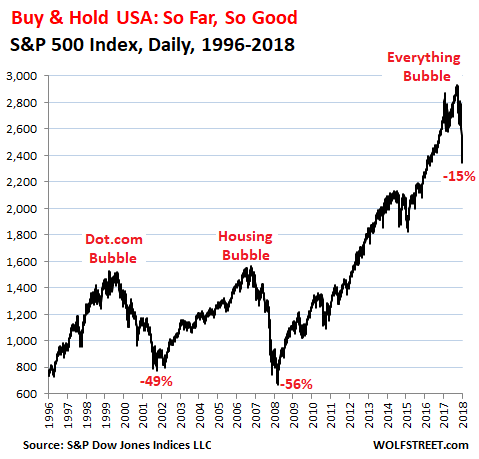
Buy & Hold in Canada, been a drag.
The Canadian stock index TSX fell 11.6% in 2018. It has moved sharply up and down for an entire decade to end up 5% below where it had been in June 2008:
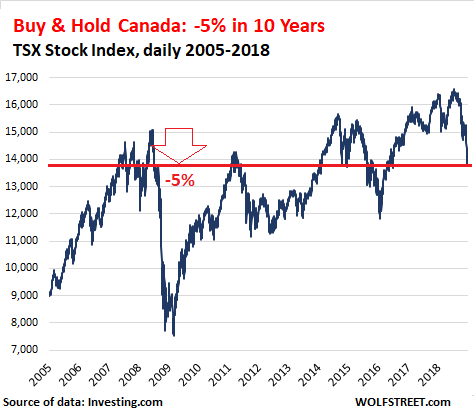
Buy & Hold in China, oh my!
Buy-and-hold did a magic job in China. The Shanghai Composite Index dropped 24.6% in 2018, closing the year at 2,494. That’s quite an accomplishment. The index is down 52% from its last bubble-peak on June 12, 2015, and down 59% from its all-time bubble-peak in October 2007. It’s now back where it had first been in December 2006.
Here’s the magnificent double-bubble and the destruction it has wreaked on buy-and-hold investors. Note that the index would have to skyrocket by 150% just to get back to where it had been at the peak in 2007:
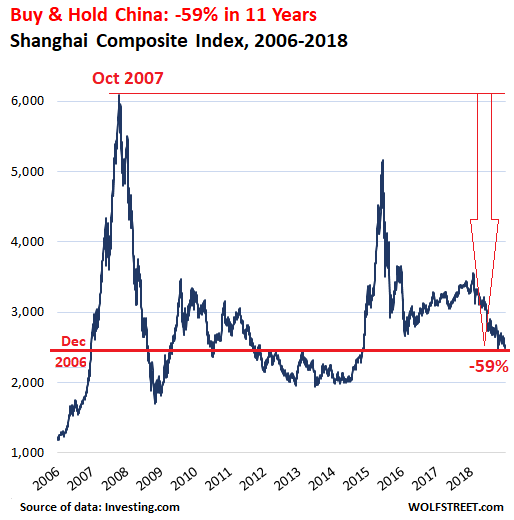
Buy & Hold in Japan, 3 decades of destruction
The Japanese stock market is the modern record-breaker in terms of buy & hold destruction: It’s already measured in decades, and it’s still going on.
The Nikkei 225 dropped 12.1% to 20,015 in 2018 and is down 18% from its 52-week high. But the historical high of the Nikkei was 38,951 in December 1989. The index is still down 49% from that peak nearly three decades ago, and is back where it had first been in February 1987, 31 years ago when many people working in finance today hadn’t even been born.
Over the past 20 years, Japan had relatively little inflation, and so the soothing veil, finely woven out of the methodical destruction of the purchasing power of the currency, has not been thrown over the index. To get back to its peak in 1989, the index would have to soar 95%:
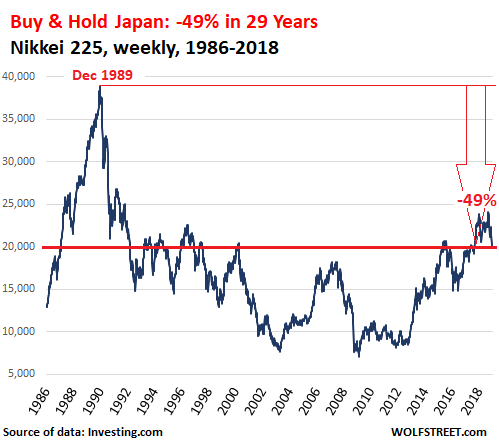
Buy & Hold in India, it gets complicated:
The other large stock market in Asia is India. This market falls into the category of markets whose results are obscured by sharp inflation and declines in the currency. At the extreme end of this category is Venezuela. Its stocks have experienced exponential price increases, as has toilet paper. When a stock market is denominated in a currency that quickly loses its purchasing power, the index says more about inflation than about stocks.
The Indian rupee has dropped nearly 50% against the USD since November 2009, largely driven by inflation (the consumer price index in India has soared 80% over the period). At the same time, the BSE Sensex stock index has risen 153%. Due to the loss of purchasing power of the rupee over the period, a big part of the stock index’s move is an expression of the devaluation of the currency. Even then, buy & hold has worked so far:
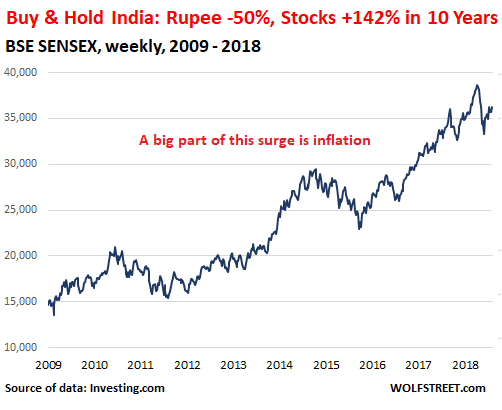
Buy & Hold in Germany, hope got gutted
The German DAX is a total-return index that includes dividends. So it is not comparable to the S&P 500 Index or any of the other indices we discuss here. So I use the DAXK index, which tracks prices-only levels (same as the S&P 500). It fell 20.6% this year and is down 24.5% from the 52-week high in January 2018. And it is down about 22% from its peak in March 2000, almost 19 years ago:
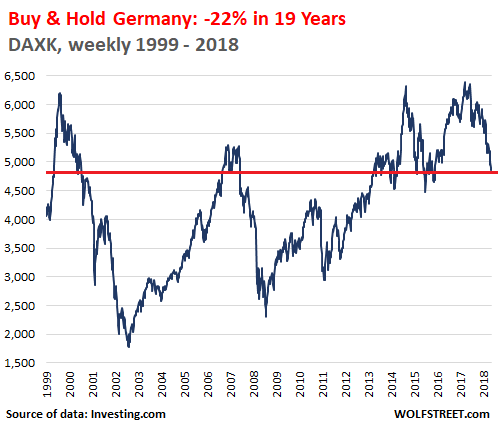
Buy & Hold in the UK, almost back to 1999
The UK’s FTSE 100 stock index reached an all-time closing high on May 22, 2018 of 7,877. But then it dropped 14.6% to close the year at 6,728. This is 3% below the peak of 6,930 in December 1999.
My data source for this, Investing.com, only offers FTSE 100 data through 2001. In the chart below, I added the high of December 1999:
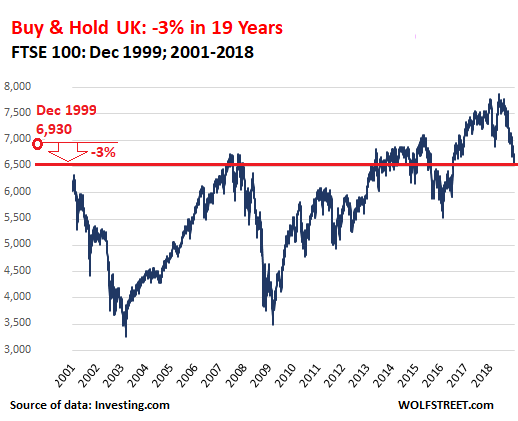
Buy & Hold in Italy: crushed, crushed, crushed
The Italian FTSE MIB stock index dropped 16.1% in 2018 to close the year at 18,324. This was down 58% from May 2007, the peak of Italy’s euro bubble. The index is still down a breath-taking 61% from the peak of the dot.com bubble in March 2000.
Note that for the index to go back to where it had been in May 2007, it would have to skyrocket by 160%. So good luck with that in the near future (chart via Trading Economics):
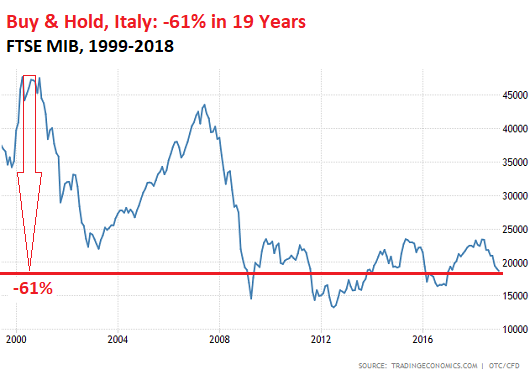
Buy & Hold in France, c’est la vie
The CAC 40 index fell 11% to 4,731 in 2018. The index is now down 22% from its euro-bubble-peak in 2007 and down 31% from the dot.com bubble-peak in September 2000:
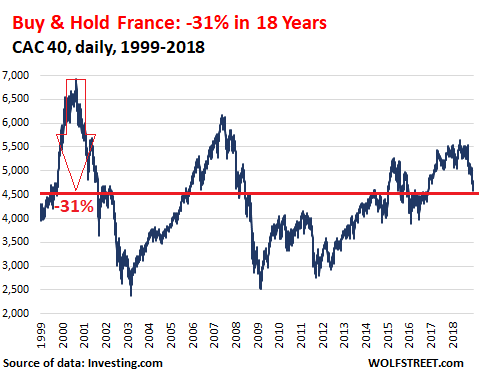
Buy & Hold in Spain, ouch!
The market in Spain is a tad too small to fit into this lineup, but since we report on Spain a lot, here it is. The stock market bubble in the dot.com era was magnificent enough, and the IBEX 35 index surged to 12,667, before crashing 58%. But then came Spain’s even more fabulous housing bubble, one of the craziest in the world, fired up by the euro bubble that other Eurozone countries also experienced. It pulled stocks with it, and the IBEX soared to 16,000 by December 2007.
It too collapsed, along with housing and banks, dragging the housing-dependent economy into a tailspin. These dynamics played a big role in the subsequent euro debt crisis. The Ibex eventually dropped 63% from the peak in 2007 to 5,956 in July 2012, before bouncing somewhat. At the end of 2018, the IBEX closed at 8,539, a level the index had first achieved in February 1998. It is now down 33% from the dot.com peak in 2000 and down 47% from the peak in December 2007:
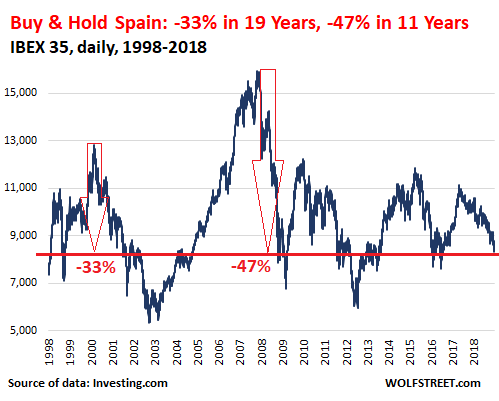
So in all but two of the largest stock markets in the world has the buy-and-hold strategy destroyed investors. So what we have learned on a global basis is this rule:
“Buy and hold works very well, as long you buy low and hold till the peak and then sell.”
With this in mind, let’s take another look at the same S&P 500 chart. This bubble-peak has outdone other bubble-peaks depicted in the above charts. And now comes the long-term aftermath of the Everything Bubble. Let’s imagine for a moment where we are in the downdraft and how long it might take to get back to the peak of September 2018, given what we have seen in Canada, China, Japan, Germany, the UK, France, Spain, and Italy:

Corporate debt, after years of encouragement by the Fed via artificially low interest rates, has reached historic levels. Now even the Fed is worried about its handiwork. Many of these companies will default over the next few years. This is a cleansing process that is part of the business cycle – only this time, it’s so much larger. Here I discuss “How the Corporate Debt Bubble Will Crush Stocks”… THE WOLF STREET REPORT
https://wolfstreet.com/2019/01/01/long-term-buy-hold-stocks-loses-in-largest-markets-except-us-india/
 S S |
|
RR Phantom

Location : Wasted Space
Job/hobbies : Cayman Islands Actuary
 |  Subject: Re: Long-Term “Buy & Hold” Crushed Stockholders in Largest Markets Except US & India. But for the US, Luck’s Running Out Subject: Re: Long-Term “Buy & Hold” Crushed Stockholders in Largest Markets Except US & India. But for the US, Luck’s Running Out  Thu Jan 03, 2019 12:33 am Thu Jan 03, 2019 12:33 am | |
| 
:I buy!: |
|

